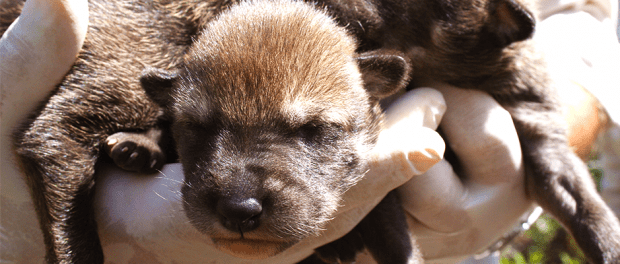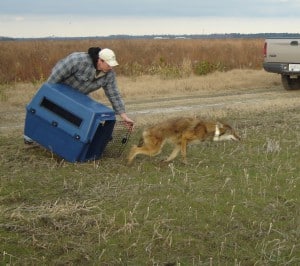 Wild red wolf pups. Image Credit: Ryan Nordsven/USFWS, licensed by cc 2.0
Wild red wolf pups. Image Credit: Ryan Nordsven/USFWS, licensed by cc 2.0“Coyote genes are under 4 percent in the red wolf genome, so that’s good,” said Eric Gese, a research wildlife biologist with the U.S. Department of Agriculture’s National Wildlife Research Center and lead author of a study recently published in Biological Conservation.
The finding is significant and could affect the pending decision by the U.S. Fish and Wildlife Service about whether or not to extend the experimental population of red wolves (Canis rufus) or remove them again from the wild.
Red wolves were declared officially extirpated from the wild by 1980, with USFWS rounding up the remaining animals and putting them into captive breeding programs. In 1987, an experimental population was released into the wild at the Alligator River National Wildlife Refuge in North Carolina. The wolves have gradually expanded their range since then, often coming into conflict with apprehensive farmers and residents in the area — some of whom have demanded the USFWS remove the experimental population again from the wild.
But by 1999, the USFWS assessed that the largest threat red wolves faced on the ground was being bred out of existence due to hybridization with coyotes (Canis latrans), said Gese, who was part of the red wolf assessment team, and is on the current red wolf recovery team. If nothing was done to stop this hybridization, the small red wolf genome would essentially be gone within a couple of decades.
The USFWS and other stakeholders needed a solution.“You can kill coyotes but you’re just going to be mowing the lawn,” Gese said, referring to the fact that coyotes would just come in to replace the ones removed from the area. Instead, he suggested a sterilization program based on a so-called placeholder concept. Basically, it meant that many coyotes in the recovery area were sterilized, eliminating the potential for successfully mating with red wolves and producing hybrid offspring. The coyote would stick around, defending the area from other intruding coyotes, but would eventually be displaced when another red wolf came along to occupy the space.
The strategy worked, Gese said.

Red wolf being released. Image Credit: Art Beyer/USFWS
“We essentially found that 37 percent of the placeholders were displaced and it led to occupancy by a red wolf.” It was also usually a female red wolf displacing the smaller female coyote, or a male wolf displacing a male coyote.
Gese said this means that if the USFWS decides to continue the experimental population when it makes its decision next year, this placeholder program would have to be continued. It would also be necessary to use if future experimental populations are introduced elsewhere.“If you didn’t do it, you will lose the red wolf as it’s known in the wild,” Gese said.
Other findings of the study include the fact that red wolves liked home ranges that seemed to have lower road densities.
But in terms of overall survival rates, the study showed that coyotes have higher survival rates than red wolves. In 12 of the 14 years they looked at in the study, the placeholder coyotes had survival rates higher than the wolves. Hybridization wasn’t always a bad thing when it came to survival, though. Red wolf-coyote hybrids also had higher survival rates than more pure red wolves — meaning they must have gained some genetic street-smart from their coyote ancestors.
 Joshua Rapp Learn is a science writer at The Wildlife Society. Contact
him at Joshua.learn@wildlife.org with tips or story suggestions on
conservation, wildlife science, management or other story ideas. @JoshuaLearn1
Joshua Rapp Learn is a science writer at The Wildlife Society. Contact
him at Joshua.learn@wildlife.org with tips or story suggestions on
conservation, wildlife science, management or other story ideas. @JoshuaLearn1Read more of Joshua's articles.
source



No comments:
Post a Comment